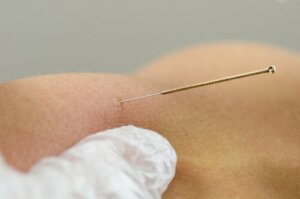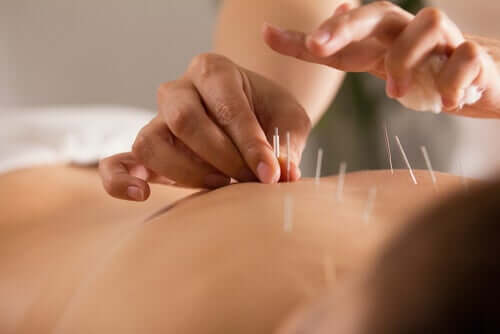Dry Needling - Description and Benefits


Written and verified by the doctor Leonardo Biolatto
Dry needling is one of the many new, innovative techniques in the field of physiotherapy.
This is a new evidence-based type of therapy technique to improve muscle pain. Today you’ll learn more about it, together with its usefulness as a treatment for all kinds of muscular problems.
To understand what dry needling is and how it works, we must clarify two concepts before proceeding: trigger point and myofascial pain.
Trigger point
These are hyperirritable points within a tight band of a certain muscle. This tight band is a group of muscle fibers that shows an abnormal tension, forming a highly consistent band. This is commonly referred to as a contraction.
This tight band is painful and its trigger point is a nodule that, on touching it, leads to the sort of sharp pain that makes a person move away. In addition, this pain radiates to other areas that don’t include the trigger point — radiating pain. It can appear along with motor dysfunction and other phenomena such as dizziness and nausea.
The trigger points of a muscle usually radiate to certain areas and give a clue to physiotherapists in regard to where the problem originates. For example, headaches can come from a trigger point located in muscles such as the upper trapezius, levator scapulae, or sternocleidomastoid.
This pain may have nothing to do with the area where it originates and the trigger points can be active or latent. An active trigger point means it radiates pain to other areas. On the other hand, if it’s latent, it means it doesn’t radiate pain.
Trigger points can be activated by acute or chronic muscle overloads, direct trauma, and cooling. The most frequent triggering factor is usually chronic overload due to postural problems.

Continue reading How Does Acupuncture Help to Treat Joint Pain?
Myofascial pain
This kind of pain is a regional muscular process that can either be acute or chronic. It’s disabling and common in the population but not many people know about it. It doesn’t usually come along with alterations in imaging or analytical tests; and, because of this, it’s underdiagnosed and undertreated.
The symptoms of myofascial pain caused by a trigger point are:
- Sensitive symptoms. There’s an alteration in the sensation of touch. For example, you’re hit by something that usually doesn’t hurt, and yet you feel pain. In addition, there’ll be radiating pain (explained above).
- Motor symptoms. There’s a decrease in strength and difficulty moving the affected muscle, among others.
- Autonomic symptoms. There’s rhinitis, lacrimation, salivation, changes in temperature, sweating, piloerection (goosebumps), dizziness, nausea, and redness on the skin.
We could say there are three components in myofascial pain:
- A palpable tight band in the affected skeletal muscle or contraction
- A trigger point
- A characteristic pattern of radiating pain, which is the trigger point that leads to pain in a specific area
The purpose of dry needling
Dry needling is a physiotherapeutic technique used mainly for myofascial pain. Once the practitioner finds the trigger point that causes it, they must deactivate it with the help of a needle. The latter is similar to the acupuncture needle but longer because it needs to reach the muscle.
The whole process requires cleaning of the area and the physiotherapist must use gloves, disinfectants, and gauze. This is because the dry spot is a semi-invasive technique as it goes through the patient’s skin. Also, the needles come in unit packages and aren’t reusable.
The practitioner inserts a needle into the trigger point without anesthetic and moves from inside to outside until it achieves a local spasm — an involuntary contraction of the muscle. They do so without actually pulling the needle out of the skin.
The puncture of the muscle stimulates the muscle receptor, producing relaxation after the spasm, an increase in elasticity, and decreases pain in the area.
Is dry needling the same as acupuncture?
Dry needling is a scientific technique in which a trained physiotherapist punctures the muscle in order to control myofascial pain. It lasts between 2 and 5 minutes and can be painful.
On the contrary, acupuncture is based on traditional Chinese medicine and they only puncture the energy points at a superficial level, without coming into contact with the muscle.
A session lasts about 20 minutes, it isn’t painful, treats many conditions, and is performed by a trained therapist.

You might like Five benefits of acupuncture that you should know
The risks of dry needling
These are minimal, however, most of them are avoidable with the corresponding precautions and when performed by a well-trained physiotherapist:
- The needle goes through the skin and into the muscle and there may be small blood vessels between these. The most common risk of dry needling is puncturing a vessel and causing a small bruise, which lasts for about a day. This risk is more common in anticoagulated patients, whose blood is thinner.
- The therapist could pinch a nerve branch on the way to the muscle. This causes tingling but it usually goes away right after.
- Another less common risk is dizziness, it may occur during the procedure. The technical term for it is “vasovagal” response.
- There are few reported cases, but if the physical therapist doesn’t have experience in dry punctures of chest muscles, their mistake could lead to a pneumothorax (collapsed lung).
- There may be muscle swelling or contraction.
- Also, it could lead to post-puncture dermatitis, a skin reaction in the puncture area.
- Finally, any puncture comes with a risk of infection if the practitioner doesn’t take adequate cleaning measures in the area. Also, if the physiotherapist doesn’t use gloves and/or sterile needles.
Dry needling can leave you with a sensation that’s similar to the one you get after a very intense massage. It subsides after 1 or 2 days though.
Contraindications of dry needling
Most of the contraindications are relative, among them:
- An insurmountable fear of needles
- Clotting problems and anticoagulant treatment due to a risk of hemorrhage
- People with weak immune systems have a higher risk of developing infections
- Lymphadenectomized people with a risk of lymphedema (This means the dry needling area fills with fluid that’s unfilterable because the lymph nodes in the area are no longer present.)
- Hypothyroidism increases the risk of muscle inflammation
Is dry needling effective?
According to several study reviews, dry needling is effective for:
- Reducing subjective and objective pain both locally and in the area of referred pain, and pain at the pressure of the trigger points
- Improving the mobility of the joints related to the muscle that houses the trigger point
- There’s insufficient evidence, but it seems dry needling may improve depression in patients with myofascial pain
Finally, practitioners observed that certain things can affect the effectiveness of dry needling. For instance, other factors in patients such as prolonged pain, lack of sleep, and repetitive work of the muscle.
Thanks for reading.
All cited sources were thoroughly reviewed by our team to ensure their quality, reliability, currency, and validity. The bibliography of this article was considered reliable and of academic or scientific accuracy.
- Mayoral-del-Moral, O., & Torres-Lacomba, M. (2009). Fisioterapia invasiva y punción seca. Informe sobre la eficacia de la punción seca en el tratamiento del síndrome de dolor miofascial y sobre su uso en Fisioterapia. Cuest. Fisioter.
- Fernández de las Peñas, C., & Dommerholt, J. (2013). Punción seca de los puntos gatillo. Una estrategia clínica basada en la evidencia. In Punción seca de los puntos gatillo. https://doi.org/10.1016/B978-84-9022-387-1.00010-3
- Mayoral del Moral, Orlando; Salvat, I. (2017). Fisioterapia invasiva del síndrome de Dolor Miofascial. Manual de punción seca de puntos gatillo. In Fisioterapia invasiva del síndrome de Dolor Miofascial. Manual de punción seca de puntos gatillo.
- “EVIDENCIA DE LA PUNCIÓN SECA COMO TRATAMIENTO DE LOS PUNTOS GATILLO.” (n.d.).
This text is provided for informational purposes only and does not replace consultation with a professional. If in doubt, consult your specialist.








